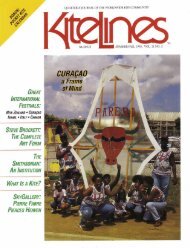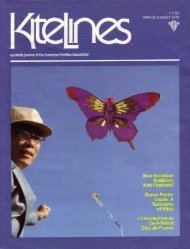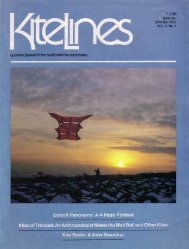Create successful ePaper yourself
Turn your PDF publications into a flip-book with our unique Google optimized e-Paper software.
UltimateStudies,Questions:TAIL-PICKING :GETTING IT UP TO A SCIENCEBy Ed GrauelIn recent years shortened windsocks,stylishly called drogues, and clusteredstreamers on a line some distance fromthe kite, sometimes called "pony tails,"have come into more common usealong with the old standard streamertails . I wanted to determine the functionaleffect of these appendages onvarious types of kites .Does a single tail, say two incheswide by ten feet long, have the sameeffect upon a kite as two tails twoinches wide by five feet long, or threetwo-inch tails, three and one-thirdfeet long? In other words, does thesame surface area, in this case 240square inches, have the same effectupon the flying characteristics of akite, whether it is in one piece or inseveral pieces, or is the length of atail more important than the amountof surface area?I attempted to resolve this questionby constructing three parawing typekites exactly alike, but each with adifferent one of the three tails as described,then 'flying the three kitesside by side in light, medium andheavy winds . The consensus of threeexperienced kitefliers observing wasthat the flying traits of the three kiteswere exactly the same under all of thewind conditions, indicating that theamount of surface area is the importantthing .For my next tests I selected fourtypes of kites on the basis of dihedral :(1) a flat kite with no dihedral ; (2)a bowed kite with positive dihedral ; (3)a Bullet kite with a negative dihedral ;and (4) a parawing (also called Flexikite)with both a positive and a negativedihedral built in .<strong>No</strong>w for the tails . I used : fourstreamers, ranging from one inchwide by six feet long to four incheswide by 15 feet long ; four pony tails,ranging from one inch wide by twofeet long to three inches wide by threefeet long, all in clusters of threestreamers with a 36-inch lead ; andfour drogues, running from five to14 inches long . For this report, it'ssimpler to call the four sizes small,standard, medium and large .Each of the four streamers, fourpony tails and four drogues was testedindividually on the four kites, andreadings were taken of : (1) the minimumamount of wind required to lifteach kite and keep it airborne ; (2)the maximum amount of wind eachkite would take before it tilted badly,power looped, power dived or becameuncontrollable ; (3) the maximum angleof elevation each kite would reachunder normal wind conditions andwithout the influence of thermals (thisangle of elevation was taken to establisha relative lift-to-drag ratio ; thehigher the angle the more lift the kitehad in relation to the amount of drag) ;and (4) opinions of the flying stabilityof the kite in each of the situationsdescribed .I posted the data collected from thesetests on 48 cards-one for each of thethree types of tails in four sizes forthe four types of kites -to permit crosscomparisons . Here are some of theresults in summary form .• What are the basic differences betweenstreamers, pony tails and drogues? Exceptfor kites with a positive dihedral,which showed little or no difference,drogues created the greatest windresistance by reducing the angle ofelevation, followed by pony tails, thenstreamers . I conclude that a fliershould try a streamer first to achievestability, then if it isn't enough trya pony tail arrangement and finallya drogue . For attractiveness or nonfunctionaluses, I suggest streamersin preference to pony tails or drogues,as they will add the least amountof drag .• Is any tail necessary? For the flat kite,of course, an appendage of some sortis needed to permit good flight . Thebowed kite performed about the samewith or without any tail . The Bulletflew about the same in light ormedium winds with or without a tail,but definitely flew better in high windswith an appendage . The parawingflew only in light winds without atail . So, except for kites with builtinpositive dihedral, you'll want a tail,at least in higher winds .• What effect does a tail haze upon theamount of wind needed to lift a kite? Theminimum amount of wind required tolift each type of kite and keep it airbornevaried only slightly, regardlessof the type or size of tail attached . Flatkites with streamers averaged four anda half miles per hour, but the use of astandard or medium-size drogue tookabout four miles per hour, while ponytails took five miles per hour- very
















